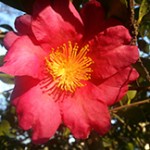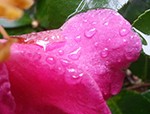 Camellia spp.
Camellia spp.
Camellia japonica and Camellia sasanqua are well known flowering evergreen ornamental shrubs or trees that will not only give you year round hardy green growth but also impressive blooms in winter. As most Texans focus on spring and summer blooming plants which are abundant and easy to grow, most landscapes are forgotten in the winter and generally appear bleak and miserable. Growing from 4 feet to 12 feet i height, the Camellia spp. is a great addition to any partially shady home that needs a focal point or accent shrub. Camellia spp. can be found with white, pink, or red single blooms with showy stamens or double blooms depending on the variety attracting bees, butterflies, and birds. The color and size of the bloom, the number of petals, leaf size, and overall size of the plant can be more or less categorized by whether your selection is a Camellia japonica or a Camellia sasanqua.
 Camellia japonica
Camellia japonica
Camellia japonica can grow from 4 feet to 12 feet tall with larger blooms than Camellia sasanqua in late winter. This species of camellia is hardy in zones 6b through 9b, and unlike Camellia sasanqua it is more upright with larger leaves and prefers part shade to full shade.
Camellia sasanqua
I find the Camellia sasanqua to be the best choice for the Texas landscape as they tend to begin blooming in late fall through early winter. The Camellia sasanqua must remain well watered and cared for throughout the year to ensure dark green foliage and prolific blooms; however, I find that an established shrub can flower abundantly with only weekly watering if it is located in partial or filtered shade. Although the Camellia sasanqua can handle more sun than the Camellia japonica, it will need more water in this less desirable location.
Varieties
Often seen in the landscape are the Camellia sasanqua ‘Yuletide’ and ‘Kanjiro’ both with brightly colored blooms and large yellow centers.
The Camellia sasanqua ‘Yuletide’ features single small stunning red blooms beginning in early November, is a best seller, and often shows blooms through Christmas. It is a compact variety that is excellent for homes and entries, although it should be maintained more regularly if planted near walkways or in planters/pots. A moderate grower, the Yuletide Camellia can grow 8′-10′ tall and wide in zones 7-10 with filtered sun, but I recommend keeping this ornamental slender not exceeding 3′-4′ wide.
The Camellia sasanqua ‘Kanjiro’ (pictured) features semi-double bright pink blooms which are sometimes mistaken for a red beginning in late November through January. The Kanjiro Camellia is considered to be a late bloomer compared to other Camellia sasanqua varieties, but I find this to be an attractive quality as it ensures an abundance of blooms throughout the winter holidays. This Kanjiro Camellia has the same growth habit and specifications as the Yuletide Camellia, but the Kanjiro seems to be an excellent candidate for a tree form ornamental up to 6′-8′ wide with a maintained canopy. It is a great replacement for a tree form Yaupon Holly in filtered sun that has become a dated selection for residences.
For all Camellia spp., the best time to prune is after the blooming period has ended which is at the end of winter/early spring. If left unpruned, seed pods will open and large hardened seeds can be collected in the fall.
Contribution by Kristin Howard and Katherine Beckett, ASLA